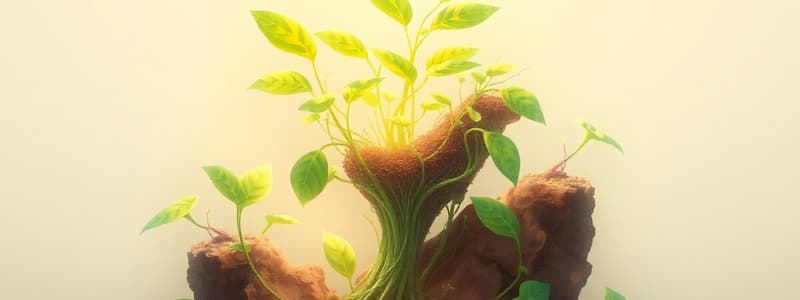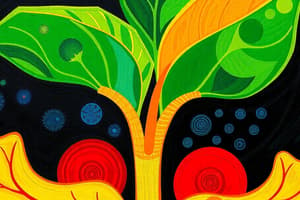Podcast
Questions and Answers
Which process is NOT a method of asexual reproduction in plants?
Which process is NOT a method of asexual reproduction in plants?
- Budding
- Vegetative Propagation
- Pollination (correct)
- Fragmentation
What is the primary distinction between gymnosperms and angiosperms?
What is the primary distinction between gymnosperms and angiosperms?
- Gymnosperms have vascular tissue; angiosperms do not.
- Gymnosperms produce flowers; angiosperms do not.
- Gymnosperms have seeds enclosed in fruits; angiosperms have exposed seeds.
- Angiosperms have seeds enclosed in fruits; gymnosperms have exposed seeds. (correct)
Which plant type is best adapted to dry environments with reduced leaves?
Which plant type is best adapted to dry environments with reduced leaves?
- Halophytes
- Hydrophytes
- Xerophytes (correct)
- Mesophytes
What is the role of xylem and phloem in plants?
What is the role of xylem and phloem in plants?
If a plant is classified as a 'monocot', what does this imply about its seed structure?
If a plant is classified as a 'monocot', what does this imply about its seed structure?
In the context of sexual reproduction in plants, where does fertilization occur?
In the context of sexual reproduction in plants, where does fertilization occur?
What is the term for the transfer of pollen between different plants?
What is the term for the transfer of pollen between different plants?
Which of the following is a significant ecological role plants perform?
Which of the following is a significant ecological role plants perform?
Which of the following best describes the primary role of xylem in plants?
Which of the following best describes the primary role of xylem in plants?
What is the main function of the stomata in leaves?
What is the main function of the stomata in leaves?
Which of the following is a characteristic that is NOT common to all plants?
Which of the following is a characteristic that is NOT common to all plants?
What is the role of petals in a flower?
What is the role of petals in a flower?
Which of these equations correctly represents the process of photosynthesis?
Which of these equations correctly represents the process of photosynthesis?
A plant with a single primary root that grows vertically downwards has what type of root system?
A plant with a single primary root that grows vertically downwards has what type of root system?
Which of the following describes the key function of a leaf's blade?
Which of the following describes the key function of a leaf's blade?
What is the primary role of the chloroplast in plant cells?
What is the primary role of the chloroplast in plant cells?
Flashcards
Multicellular Organisms
Multicellular Organisms
Plants are living organisms composed of many specialized cells organized into tissues.
Cell Wall
Cell Wall
A rigid layer surrounding plant cells, providing structure and protection, made primarily of cellulose.
Photosynthesis
Photosynthesis
The process by which plants use sunlight, carbon dioxide, and water to produce glucose (sugar) and oxygen.
Autotrophic Nutrition
Autotrophic Nutrition
Signup and view all the flashcards
Taproot
Taproot
Signup and view all the flashcards
Fibrous Roots
Fibrous Roots
Signup and view all the flashcards
Adventitious Roots
Adventitious Roots
Signup and view all the flashcards
Stem
Stem
Signup and view all the flashcards
Asexual Reproduction in Plants
Asexual Reproduction in Plants
Signup and view all the flashcards
Budding
Budding
Signup and view all the flashcards
Pollination in Plants
Pollination in Plants
Signup and view all the flashcards
Self-Pollination
Self-Pollination
Signup and view all the flashcards
Non-vascular Plants
Non-vascular Plants
Signup and view all the flashcards
Vascular Plants
Vascular Plants
Signup and view all the flashcards
Seedless Plants
Seedless Plants
Signup and view all the flashcards
Gymnosperms
Gymnosperms
Signup and view all the flashcards
Study Notes
Plant Characteristics
- Plants are multicellular organisms, mostly autotrophic.
- They have cell walls made of cellulose, offering structure and protection.
- Chlorophyll allows plants to photosynthesize, creating glucose and oxygen.
- Reproduction happens through both sexual methods (flowers, seeds) and asexual methods (vegetative propagation).
- Vascular tissues (xylem and phloem) transport water, nutrients, and food throughout the plant.
Plant Structure
Roots
- Roots anchor the plant, absorb water and minerals, and store nutrients.
- Taproots have a single main root (carrot).
- Fibrous roots have many thin roots (grass).
- Adventitious roots develop from non-root tissues (maize).
Stems
- Stems support the plant, transport substances, and store food.
- Herbaceous stems are soft and flexible (sunflowers).
- Woody stems are hard and rigid (trees).
Leaves
- Leaves are the primary sites for photosynthesis and gas exchange.
- The leaf blade captures sunlight for optimal photosynthesis.
- The petiole connects the leaf to the stem.
- Stomata, controlled by guard cells, are small openings for gas exchange.
Flowers
- Flowers facilitate sexual reproduction in plants.
- Sepals protect the flower bud.
- Petals attract pollinators.
- Stamens are the male parts (anther and filament), producing pollen.
- Carpels are the female parts (stigma, style, ovary), where fertilization takes place.
Photosynthesis
- Plants transform light energy into chemical energy (glucose).
- The photosynthesis equation: 6CO₂ + 6H₂O + Light → C₆H₁₂O₆ + 6O₂
- Chloroplasts, containing chlorophyll, capture light energy.
- Photosynthesis produces energy for plant growth and oxygen for respiration.
Plant Reproduction
Asexual Reproduction
- New plants grow from parts of existing plants.
- Methods include budding (potatoes), fragmentation, and vegetative propagation (runners in strawberries).
Sexual Reproduction
- Transferring pollen (male) to the stigma (female) is pollination.
- Self-pollination involves pollen from the same flower or plant.
- Cross-pollination involves pollen from a different plant.
- Fertilization fuses male and female gametes, leading to seed and fruit production.
Plant Classification
Vascular Tissue
- Non-vascular plants lack xylem and phloem, transporting water and nutrients differently.
- Vascular plants have xylem and phloem, facilitating internal transport.
Reproductive Structures
- Seedless plants reproduce via spores (e.g., ferns).
- Seed plants produce seeds.
- Gymnosperms produce naked seeds not enclosed in fruits (e.g., pine trees).
- Angiosperms produce seeds enclosed in fruits (e.g., mango trees).
Flowering Plants
- Angiosperms have flowers for reproduction.
- Divided into monocots (one cotyledon) and dicots (two cotyledons).
Plant Adaptations
- Hydrophytes thrive in water (e.g., lotus).
- Xerophytes survive in dry conditions with adaptations like reduced leaves (e.g., cactus).
- Mesophytes thrive in moderate environments (e.g., grasses).
Importance of Plants
- Plants are vital for many ecosystem processes, producing oxygen and forming the base of food chains.
- Plants provide essential resources like food, medicine, and building materials.
Human Impact on Plants
- Human activities like deforestation and pollution threaten plant biodiversity.
- Conservation efforts aim to protect plants through afforestation and sustainable practices.
Studying That Suits You
Use AI to generate personalized quizzes and flashcards to suit your learning preferences.




